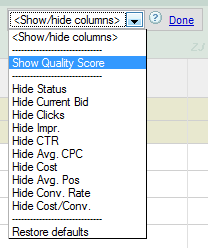This post is about saving money, specifically for you and your Google Adwords expenditures.

Many are not familiar with the powerful new approach that Google introduced in its paid-click model (pay-per-click advertising). While Goto/Overture was the pioneer by introducing paid search initially (paid advertising, sponsored links), Google came on the scene about 2002 and introduced a different “smart reward” system for performance-based ads management and relevancy of overall bidding, keywords and user experience.
This new, enhanced system allowed the engine to not only allow a bid to position ranking, but to use its own (secret) software-tailored intelligence to improve cost per click by ranking you better than your competition, at a (if done right) lower cost. If your competitor was paying $2 per click for a keyword, for example, you could pay less ($1.50, say), and still be ranked ahead of the competition.
While the current Quality Score (QS) was introduced later and improved over time, it is an important component of the Adwords system today. It is something you should try to understand and apply across all your current accounts.
The Quality Score algorithm in Adwords (search ads and search network are slightly different) is not revealed for obvious reasons (spamming/black hat), but allows ads you create to lift into better positions (ad rank) and lowered price per click based on a few factors you can easily control–or at least try to make “least imperfect.”
Top factors that influence positive, money-saving opportunities using Adwords:
- Keyword use and relevancy in ad creative (ad text);
- Tight adgroup matching to content/keywords (Do not dilute with lots of keywords that are not related);
- Landing page copy and keyword relevancy from bid (the Google Adsbot reads and records keywords on page, similar to Google Bot);
- Minimum keyword bid;
- Ad positioning, monitoring; and
- Click-through rates (CTR) and overall performance history across your campaigns.
Please read further quality scoring resources below, but here are the top three quickest ways to affect your budget and performance:
1. Keyword matching in title of ad, included in body as well (derivative keyword, plurals, etc). Don’t miss this.
2. Ensure keyword(s) are included and reflected early and often in landing page text, including SEO compliant page setup (Title, description, H1 tags, related keywords in body content, etc). Include more than just graphics and a few bullet points.
3. Watch your CTR percentage and tune it upward by creating A/B ads and testing their performance. Remove or pause underperforming keywords; they can affect your QS negatively.
Your competition may be using techniques like these already. Study their landing pages as well, including keyword use for relevancy. Then do all this slightly better, and you will win, while optimizing your Google Adwords budget. Make sure not only to optimize for Google, but learn the best practices for high landing page conversion by reading further materials at MarketingSherpa.
Adding links and pages About Us, Contact Us, Privacy Policy, SiteMap and SSL certificates for secure transactions are included as positive QS parameters for all landing pages.
You can review your Quality Score grade right inside the Adwords system:

Additional Resources:
1. What Google Quality Score is–and is not
2. Quality Score for Google and network
3. How is the Google Quality Score calculated?
4. Landing pages’ load time will be included in Quality Scoring Adwords
MSN & Yahoo resources also:
1. MSN Quality Scoring
2. Yahoo Quality Scoring/Index
Lastly, to manage the Google Adwords system, save yourself tons of time. Read up on the Adwords Editor features and download it today (it’s free).